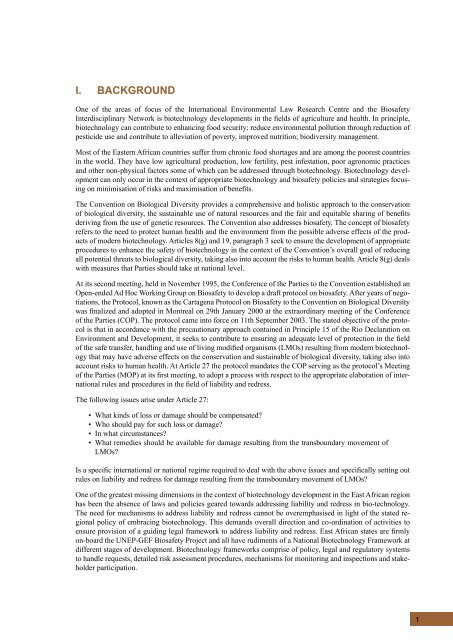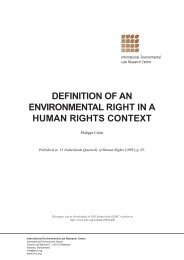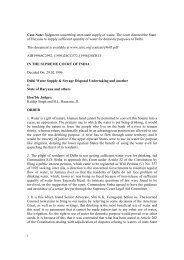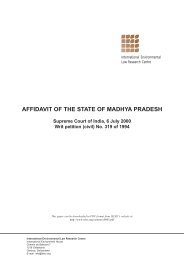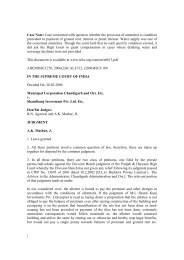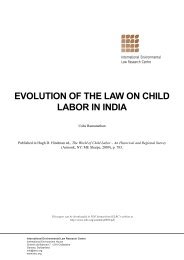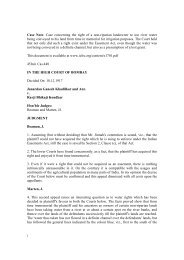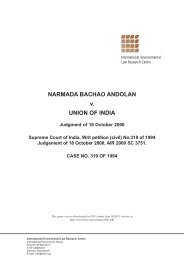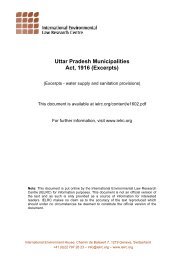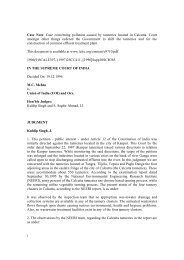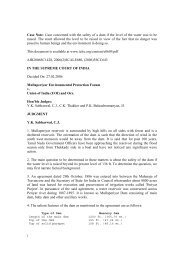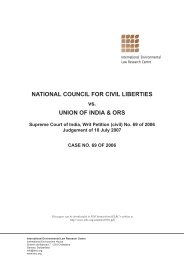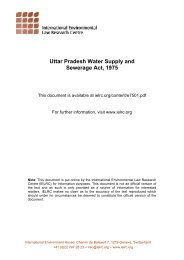Liability and Redress under the Cartagena Protocol - International ...
Liability and Redress under the Cartagena Protocol - International ...
Liability and Redress under the Cartagena Protocol - International ...
Create successful ePaper yourself
Turn your PDF publications into a flip-book with our unique Google optimized e-Paper software.
I. BACKGROUNDOne of <strong>the</strong> areas of focus of <strong>the</strong> <strong>International</strong> Environmental Law Research Centre <strong>and</strong> <strong>the</strong> BiosafetyInterdisciplinary Network is biotechnology developments in <strong>the</strong> fields of agriculture <strong>and</strong> health. In principle,biotechnology can contribute to enhancing food security; reduce environmental pollution through reduction ofpesticide use <strong>and</strong> contribute to alleviation of poverty, improved nutrition; biodiversity management.Most of <strong>the</strong> Eastern African countries suffer from chronic food shortages <strong>and</strong> are among <strong>the</strong> poorest countriesin <strong>the</strong> world. They have low agricultural production, low fertility, pest infestation, poor agronomic practices<strong>and</strong> o<strong>the</strong>r non-physical factors some of which can be addressed through biotechnology. Biotechnology developmentcan only occur in <strong>the</strong> context of appropriate biotechnology <strong>and</strong> biosafety policies <strong>and</strong> strategies focusingon minimisation of risks <strong>and</strong> maximisation of benefits.The Convention on Biological Diversity provides a comprehensive <strong>and</strong> holistic approach to <strong>the</strong> conservationof biological diversity, <strong>the</strong> sustainable use of natural resources <strong>and</strong> <strong>the</strong> fair <strong>and</strong> equitable sharing of benefitsderiving from <strong>the</strong> use of genetic resources. The Convention also addresses biosafety. The concept of biosafetyrefers to <strong>the</strong> need to protect human health <strong>and</strong> <strong>the</strong> environment from <strong>the</strong> possible adverse effects of <strong>the</strong> productsof modern biotechnology. Articles 8(g) <strong>and</strong> 19, paragraph 3 seek to ensure <strong>the</strong> development of appropriateprocedures to enhance <strong>the</strong> safety of biotechnology in <strong>the</strong> context of <strong>the</strong> Convention’s overall goal of reducingall potential threats to biological diversity, taking also into account <strong>the</strong> risks to human health. Article 8(g) dealswith measures that Parties should take at national level.At its second meeting, held in November 1995, <strong>the</strong> Conference of <strong>the</strong> Parties to <strong>the</strong> Convention established anOpen-ended Ad Hoc Working Group on Biosafety to develop a draft protocol on biosafety. After years of negotiations,<strong>the</strong> <strong>Protocol</strong>, known as <strong>the</strong> <strong>Cartagena</strong> <strong>Protocol</strong> on Biosafety to <strong>the</strong> Convention on Biological Diversitywas finalized <strong>and</strong> adopted in Montreal on 29th January 2000 at <strong>the</strong> extraordinary meeting of <strong>the</strong> Conferenceof <strong>the</strong> Parties (COP). The protocol came into force on 11th September 2003. The stated objective of <strong>the</strong> protocolis that in accordance with <strong>the</strong> precautionary approach contained in Principle 15 of <strong>the</strong> Rio Declaration onEnvironment <strong>and</strong> Development, it seeks to contribute to ensuring an adequate level of protection in <strong>the</strong> fieldof <strong>the</strong> safe transfer, h<strong>and</strong>ling <strong>and</strong> use of living modified organisms (LMOs) resulting from modern biotechnologythat may have adverse effects on <strong>the</strong> conservation <strong>and</strong> sustainable of biological diversity, taking also intoaccount risks to human health. At Article 27 <strong>the</strong> protocol m<strong>and</strong>ates <strong>the</strong> COP serving as <strong>the</strong> protocol’s Meetingof <strong>the</strong> Parties (MOP) at its first meeting, to adopt a process with respect to <strong>the</strong> appropriate elaboration of internationalrules <strong>and</strong> procedures in <strong>the</strong> field of liability <strong>and</strong> redress.The following issues arise <strong>under</strong> Article 27:• What kinds of loss or damage should be compensated?• Who should pay for such loss or damage?• In what circumstances?• What remedies should be available for damage resulting from <strong>the</strong> transboundary movement ofLMOs?Is a specific international or national regime required to deal with <strong>the</strong> above issues <strong>and</strong> specifically setting outrules on liability <strong>and</strong> redress for damage resulting from <strong>the</strong> transboundary movement of LMOs?One of <strong>the</strong> greatest missing dimensions in <strong>the</strong> context of biotechnology development in <strong>the</strong> East African regionhas been <strong>the</strong> absence of laws <strong>and</strong> policies geared towards addressing liability <strong>and</strong> redress in bio-technology.The need for mechanisms to address liability <strong>and</strong> redress cannot be overemphasised in light of <strong>the</strong> stated regionalpolicy of embracing biotechnology. This dem<strong>and</strong>s overall direction <strong>and</strong> co-ordination of activities toensure provision of a guiding legal framework to address liability <strong>and</strong> redress. East African states are firmlyon-board <strong>the</strong> UNEP-GEF Biosafety Project <strong>and</strong> all have rudiments of a National Biotechnology Framework atdifferent stages of development. Biotechnology frameworks comprise of policy, legal <strong>and</strong> regulatory systemsto h<strong>and</strong>le requests, detailed risk assessment procedures, mechanisms for monitoring <strong>and</strong> inspections <strong>and</strong> stakeholderparticipation.1


